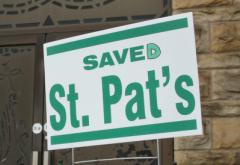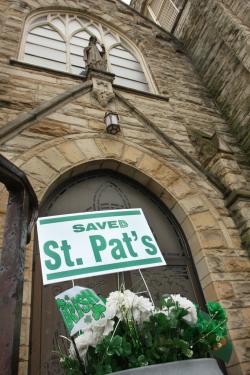Cleveland Parishes Await Lennon's Response
By Brian Roewe
Joyful in their victory, parishioners of 13 Cleveland parishes who successfully appealed to the Vatican a diocesan decision to disband their communities and shutter their church doors now await the response of their bishop, the Most Rev. Richard G. Lennon. As they wait, it’s unclear what sticking power Rome’s decision to reopen their parishes will have. Those close to the parishes view the decrees from the Vatican’s Congregation of the Clergy as a landmark decision, while others see it as a still murky scene where a possible appeal by Lennon could succeed. “This decision was made on procedural, not substantive or pastoral, grounds,” said Jesuit Fr. Tom Reese, a senior fellow at Georgetown University’s Woodstock Theological Center, adding that if Lennon redoes the process under proper procedure, the closings will likely stand. An adviser to the appealing parishes disagrees. Peter Borre, a leader with the Boston-based Council of Parishes, said the last two paragraphs of the decree, which contain the force of law, “stated both with regard to the parish suppression and the closing of the church that [Lennon] has erred procedurally and substantively.” A statement released Monday by the diocese said it “has not formally received from the Vatican any decrees from the Congregation of the Clergy concerning parish appeals” and that no response will be available until Lennon has received notification. Calls to Robert Taydek, a diocesan spokesperson, for comment were not returned by Monday afternoon.
Beginning in August 2009, Lennon closed 50 churches in a downsizing process across the eight-county diocese, with the last church shuttering in June 2010. Initially unveiling the plan in March 2009, Lennon, a former auxiliary bishop in the Boston archdiocese, cited demographic shifts, a shortage of priests and financial troubles as the rationale for his decision. Those affiliated with the appealing parishes learned Wednesday of the decision made by the Vatican congregation, with some receiving notice even earlier. “I received these decrees legitimately on Monday [March 5], so I find it passing strange that the bishop of a major diocese is still claiming that the check is in the mail, so to speak, but strange things happen,” Borre said. The decrees, a number of which were obtained by NCR, are signed by Cardinal Mauro Piacenza, the prefect of the Congregation, and state that Lennon erred both procedurally and substantively in his suppression of the parishes and in the closing of their churches. The Congregation cites two canon laws as basis for their decisions to overturn Lennon’s closings. Canon Law 515 defines what constitutes a parish and states a bishop “is neither to erect, suppress, nor alter notably parishes, unless he has heard the presbyteral council.” Canon 1222 states a bishop can relegate a church to profane but not sordid use, but only after having heard the presbyteral council and “with the consent of those who legitimately claim rights from themselves in the church.” No matter the uncertainty of Lennon’s response, announcement of the decrees gave way to what Borre called an “explosion of joy” among parishioners engaged in a three-year process to reestablish their parishes. Patricia Schulte-Singleton, president of a coalition of estranged parishioners called Endangered Catholics, said in a phone interview her initial reaction to the news was, “Oh my God, this is unbelievable,” and that others look forward to standing once again in their home parishes. She said she has received many calls already from people eager to begin cleaning the church buildings. The candlelight prayer services held among many parish communities over the weekend heralded a tone of rejoicing and thanksgiving after a year-and-a-half period of prayers for hope and strength. Since the doors closed on their church, a group of women from the St. Patrick parish prayed the rosary five days a week in the chapel of the Sisters of St. Joseph mother house. “We’ve been asking for the intercession of our Blessed Mother, and we believe she came through for us,” Schulte-Singleton said. The head of the church reform group FutureChurch, which has provided resources to the Cleveland parishes as well as others that have been closed across the country, also expressed hope. “For me, this is the voice of the people of God making itself heard all the way to Rome and back and being validated,” said St. Joseph Sr. Christine Schenk, the group’s executive director. Borre hailed the decrees as a landmark decision and said canon lawyers in Rome he consulted could not find evidence in reviewing more than 100 cases involving parishioner appeals one where the congregation ruled in favor of their favor. In reviewing rulings by the Apostolic Signatura, the Vatican’s Supreme Court, his lawyers found only one U.S. case where a parish suppression had been reversed, though only on procedural grounds. “By these decrees, and it’s unambiguous, it means that these parishes are now restored canonically. And it means that these padlocked churches are now parochial churches to which the faithful have the right of access, as of now,” he said. One canon lawyer said while it appears Lennon had “badly botched” the church-closing procedure, the issues the congregation had with the process were “primarily procedural.” “It does appear that the defects identified by the Congregation are primarily procedural,” said Fr. John Beal, a canon lawyer at the Catholic University of America, in an email. “If the findings of fact in the decrees are correct, Bishop Lennon badly botched the procedure for closing/suppressing the parishes and completely ignored the separate process for reducing the two parish churches to profane use. “In fact, it does not appear that he appreciated the fact that two separate procedures with different criteria are required. In other cases, the Congregation has been extremely demanding on reducing churches to profane use and insisting on demonstrably ‘grave causes.’” Borre said he believed that the congregation, so irritated with Lennon, purposefully highlighted his “procedural flubs and the back-and-forth that they went through to try and get a nonexistent decree.” “The language of the decree language states very clearly that we the parishioners are upheld de procedendo, as a matter of procedure, and de decernendo, as a matter of substantive canon law,” he said. In terms of what happens next, Schulte-Singleton said the coalition intends to give the bishop respectable time to come up with a response to the decision, but has indicated it won’t wait forever. Borre said he has advised the parishioners to wait days, not weeks, for Lennon to respond. If he fails to do so, Borre said he will recommend the parishioners write a short, respectful letter to Lennon demanding compliance with the decrees. If the bishop fails to respond after that, the parishioners could look to file emergency motions in Rome urging the congregation to demand his compliance with their orders. Lennon has the option to appeal the congregation’s ruling by taking the case to the Apostolic Signatura. Regardless of the action he ultimately takes, parishioners and their supporters say the decree orders him to open the churches immediately. “[An appeal is] within his rights; however, the status quo now canonically is that these 13 things are Catholic parishes, and the 13 padlocked buildings are parochial churches with full standing,” Borre said. “He can go to the Signatura and tie himself up in knots for the next year, but we will demand that the congregation’s order be executed now, so that while this appeal grinds on in Rome for a year or so, these are functioning parishes and the churches are opened for ordinary Catholic worship.” Schulte-Singleton and her fellow St. Patrick parishioners have set their sights on their patron saint’s feast day, March 17, as the day their church doors reopen for liturgical celebrations. Both Singleton and Borre said Holy Week is their target date for the reopening of all 13 parishes. “If these churches are not physically reopened and in good shape as we approach Palm Sunday, then we will know Lennon’s true colors,” said Borre. “And we will be engaged in another campaign. And having had the steadfastness to fight him for the last three years, now that we enjoy the support of a Rome decree, we will continue this fight.” [Brian Roewe is an NCR Bertlesen intern.]
|
.
Any original material on these pages is copyright © BishopAccountability.org 2004. Reproduce freely with attribution.

